Documents: Go to download!
User Manual
- User Manual - (English)
- Sharp Roku User Guide 19 0162 WEB V1 SP Final lr - (Spanish)
- Sharp Roku User Guide 19 0162 WEB V1 FR Final lr - (French)
- Sharp LC 43LBU711C 50 55 18 0691 QSG V1 EN Final Press - (English)
- LC 43LBU711C 19 0066 MKTG V1 final print v3 - (English)
- TV components
- Connecting a cable or satellite box
- Connecting an antenna or cable TV (no box)
- Connecting a DVD or Blu-ray player
- Connecting a game console
- Connecting a computer
- Connecting to Ethernet
- Connecting a USB flash drive
- Connecting headphones
- Connecting external speakers or a sound bar
- Connecting power
- Installing remote control batteries
- Setting up your TV
- Maintaining
- Troubleshooting
Table of contents
TV components
TV front
You can find these items on the front of your TV.
| ITEM | DESCRIPTION |
| Remote control | Receives signals from the remote control. Do not block. |
| Power indicator | Turns off when your TV is on. Lights when your TV is off (standby mode) |
Jacks and controls
Your TV may have any of the following items:

Cautions!
- Check the jacks for position and type before making any connections.
- Loose connections can cause poor audio or video quality. Make sure that all connections are tight and secure.
- The external audio/video equipment shown may be different from your equipment. If you have questions, refer to the documentation that came with your equipment.
- Always unplug the power cord when connecting external equipment.
Remote control
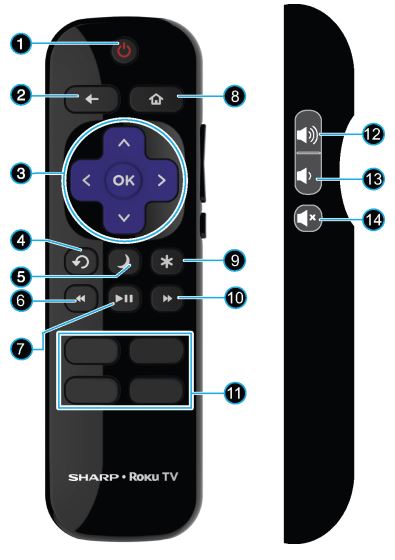
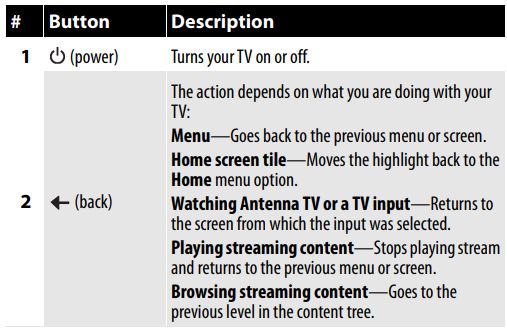


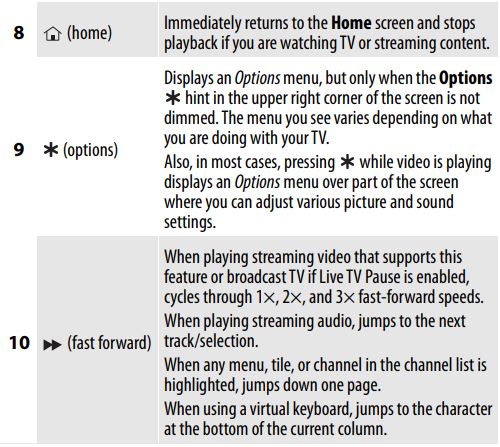
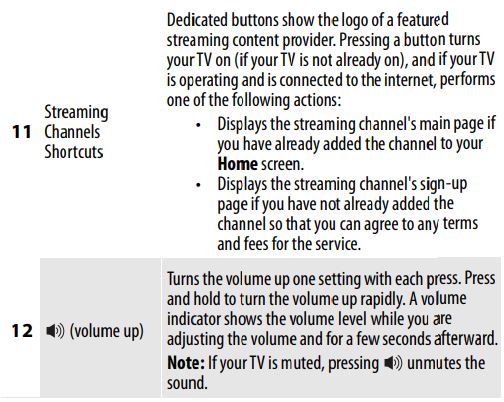
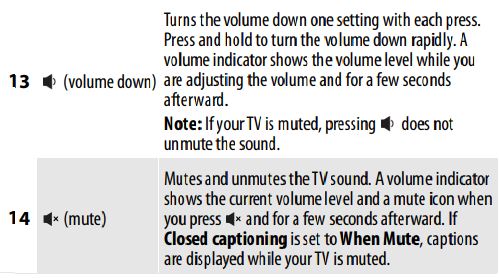
Connecting a cable or satellite box
HDMI (best)

- Make sure that your TV’s power cord is unplugged and all connected equipment is turned off.
- Connect a coaxial cable (not provided) to the cable wall jack and to the cable-in jack on the cable or satellite box.
- Connect an HDMI® cable (not provided) to one of the HDMI jacks on your TV and to the HDMI® out jack on the cable or satellite box.
- Plug your TV’s power cord into a power outlet, turn on your TV, then turn on the cable or satellite box.
- On the Home screen, press ^ < or > to highlight the HDMI 1, HDMI 2, or HDMI 3 tile, then press OK.
Note: An HDMI® cable carries both audio and video. You do not need to use any audio cables.
AV (good)
Note: Cables are often color-coded to match color-coded jacks.

- Make sure that your TV’s power cord is unplugged and all connected equipment is turned off.
- Connect a coaxial cable (not provided) to the cable wall jack and to the cable-in jack on the cable or satellite box.
- Connect an AV cable (not provided) to the AV jacks on your TV and to the AV out jacks on the cable or satellite box.
Important: When you connect the audio using the AV jacks, the audio output is analog. - Plug your TV’s power cord into a power outlet, turn on your TV, then turn on the cable or satellite box.
- On the Home screen, press ^ < or > to highlight the AV tile, then press OK.
Coaxial (good)

- Make sure that your TV’s power cord is unplugged and all connected equipment is turned off.
- Connect a coaxial cable (not provided) to the cable wall jack and to the cable-in jack on the cable or satellite box.
- Connect another coaxial cable (not provided) to the antenna/cable jack on your TV and to the coaxial out jack on the cable or satellite box.
- Plug your TV’s power cord into a power outlet, turn on your TV, then turn on the cable or satellite box.
- On the Home screen, press ^ < or > to highlight the Antenna TV tile, then press OK. If you have not set up the TV tuner, follow the on-screen instructions.
Connecting an antenna or cable TV (no box)

- Make sure that your TV’s power cord is unplugged and all connected equipment is turned off.
- Connect a coaxial cable (not provided) to the antenna/cable jack on your TV and to the antenna or cable TV wall jack.
- Plug your TV’s power cord into a power outlet, then turn on your TV.
- On the Home screen, press ^ < or > to highlight the Antenna TV tile, then press OK. If you have not set up the TV tuner, follow the on-screen instructions.
Notes:
- Use a coaxial cable to eliminate interference and noise from radio waves.
- If the antenna is not installed correctly, contact qualified service personnel to correct the problem.
- If the signal level for a channel is weak, the picture may be distorted. Adjust the antenna or use a highly directional outdoor or set-top antenna with a built-in amplifier.
- If the picture quality is good on some channels and poor on others, the problem may be caused by a poor or weak signal from the broadcaster or cable TV provider.
- If you connect to cable TV without a set-top box and experience poor picture quality, you may need to install a set-top box to improve signal reception and picture quality. Contact your cable TV provider about upgrading to a set-top box.
- Many high-definition (HD) channels upscale standard-definition (SD) content. The picture displayed on your TV is still displayed as SD, thus the picture quality will not be as clear or crisp as it would be if the content was originally recorded in HD.
Connecting a DVD or Blu-ray player
HDMI (best)

- Make sure that your TV’s power cord is unplugged and the DVD or Blu-ray player is turned off.
- Connect an HDMI® cable (not provided) to one of the HDMI jacks on your TV and to the HDMI® out jack on the DVD or Blu-ray player.
- Plug your TV’s power cord into a power outlet, then turn on your TV and DVD or Blu-ray player.
- On the Home screen, press ^ < or > to highlight the HDMI 1, HDMI 2, or HDMI 3 tile, then press OK.
AV (good)

- Make sure that your TV’s power cord is unplugged and the DVD or Blu-ray player is turned off.
- Connect an AV cable (not provided) to the AV jacks on your TV and to the AV out jacks on the DVD or Blu-ray player.
- Plug your TV’s power cord into a power outlet, then turn on your TV and DVD or Blu-ray player.
- If needed, set the player to the correct output mode. See the documentation that came with the player.
- On the Home screen, press ^ < or > to highlight the AV tile, then press OK.
Connecting a game console
HDMI (best)

- Make sure that your TV’s power cord is unplugged and the game console is turned off.
- Connect an HDMI® cable (not provided) to one of the HDMI jacks on your TV and to the HDMI® out jack on the game console.
- Plug your TV’s power cord into a power outlet, then turn on your TV.
- Turn on the game console, then set it to the correct output mode. See the documentation that came with the console.
- On the Home screen, press ^ < or > to highlight the HDMI 1, HDMI 2, or HDMI 3 tile, then press OK.
AV (good)

- Make sure that your TV’s power cord is unplugged and the game console is turned off.
- Connect the console-specific AV cable to the AV jacks on your TV and to the AV jack(s) on the game console.
Important:
• Some older game consoles come with a special AV cable. See the documentation that came with your game console or check the manufacturer’s website.
• When you connect the audio using the AV jacks, the audio output is analog. - Plug your TV’s power cord into a power outlet, then turn on your TV.
- Turn on the game console, then set it to the correct output mode. See the documentation that came with the console.
- On the Home screen, press or to highlight the AV tile, then press OK.
Connecting a computer

- Make sure that your TV’s power cord is unplugged and the computer is turned off.
- Connect an HDMI® cable (not provided) to one of the HDMI jacks on your TV and to the HDMI® out jack on the computer.
- Plug your TV’s power cord into a power outlet, then turn on your TV and the computer.
- On the Home screen, press ^ < or > or to highlight the HDMI 1, HDMI 2, or HDMI 3 tile, then press OK.
- Adjust the display properties on the computer, if necessary.
Connecting to Ethernet
To access the internet, you must connect to a LAN (Ethernet) network or use Wi-Fi to access the internet.

- Make sure that your TV’s power cord is unplugged and the router is turned off.
- Connect an Ethernet cable (not provided) to the ETHERNET jack on your TV and to an Ethernet jack on the router.
- Plug your TV’s power cord into a power outlet, then turn on your TV.
- During Guided Setup, select Wired (Ethernet) > Connect to wired network to use your wired connection to access the Internet and your Roku account.
Connecting a USB flash drive
When you connect a USB flash drive to the USB jack on your TV, you can view photos and videos or listen to music stored on the drive or you can use the Live TV Pause feature to pause live TV for up to 90 minutes.
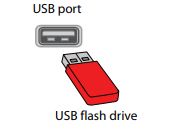
- Plug a USB flash drive into the USB port on your TV.
Caution! Do not remove the USB flash drive or turn off the TV while using the USB flash drive. You may lose data or damage the USB flash drive. - Press ∧ or ∨ to highlight the Roku Media Player or USB Media Player tile, then press OK
Connecting headphones
When you connect headphones, the TV speakers are muted.
Connect the headphones to the headphone jack on your TV:

Notes: You can also connect a home theater system, sound bar, or external speaker system to the headphone jack.
Connecting external speakers or a sound bar
Digital audio using the digital optical audio jack

- Make sure that your TV’s power cord is unplugged and the digital speaker system or sound bar is turned off.
- Connect a digital optical audio cable (not provided) to the digital audio output jack on your TV and to the audio input jack on the digital speaker system or sound bar.
- Plug your TV’s power cord into a power outlet, then turn on your TV.
- Turn on the digital speaker system or sound bar, then set it to the correct source. See the documentation that came with the digital speaker system or sound bar.
- To turn off your TV speakers, on the Home screen, press ∧∨ < or > to highlight Settings, then press OK. Highlight Audio, then press OK. Highlight TV speakers, then press OK. Press OK to remove the check from the TV speakers enabled check box.
Digital audio using the HDMI/ARC jack
Your TV can send sound to an ARC device, like an AV receiver, to create a home theater that uses two or more speakers. When you connect external speakers or a sound bar, sound plays through your TV speakers and the external speakers or sound bar.

- Make sure that your TV’s power cord is unplugged and the digital speaker system or sound bar is turned off.
- Connect an HDMI® cable (not provided) to the HDMI/ARC jack on your TV and to the audio in jack on the digital speaker system or sound bar.
- Plug your TV’s power cord into a power outlet, then turn on your TV.
- Turn on the digital speaker system or sound bar, then set it to the correct source. See the documentation that came with the digital speaker system or sound bar.
- To configure the HDMI1(ARC) jack to output sound to an ARC device, on the Home menu, press or to highlight Settings, then press OK. Highlight System, then press OK. Highlight Control other devices (CEC), then press OK. Highlight HDMI ARC, then press OK to check the box.
- To turn off your TV speakers, on the Home screen, press ∧∨ < or > to highlight Settings, then press OK. Highlight Audio, then press OK. Highlight TV speakers, then press OK. Press OK to remove the check from the TV speakers enabled check box.
Analog audio using the audio out jack
When you connect an analog speaker system or sound bar to the audio out jack, the TV speakers are muted.

- Make sure that your TV’s power cord is unplugged and the analog speaker system or sound bar is turned off.
- Connect an audio cable (not provided) to the audio out jack on your TV and to the audio in jacks on the analog speaker system or sound bar.
- Plug your TV’s power cord into a power outlet, then turn on your TV.
- Turn on the analog speaker system or sound bar, then set it to the correct source. See the documentation that came with the analog speaker system or sound bar.
- To turn off your TV speakers, on the Home screen, press ∧∨ < or > to highlight Settings, then press OK. Highlight Audio, then press OK. Highlight TV speakers, then press OK. Press OK to remove the check from the TV speakers enabled check box.
Note: Use the volume controls on the analog speaker system or sound bar to control the volume.
Connecting power
- If your power cord is not permanently connected to your TV, connect it to the power connector on your TV.
- Connect the power cord to a power outlet.
CAUTION!
- Your TV should only be operated from the power source indicated on the label.
- Always unplug the power cord from the power outlet when you will not be using your TV for an extended period of time.
- If the power cord is permanently attached to your TV, do not try to unplug it from your TV.
Installing remote control batteries
Open the back of your TV remote control and insert two AAA batteries, observing the proper orientation. Reattach the back cover.
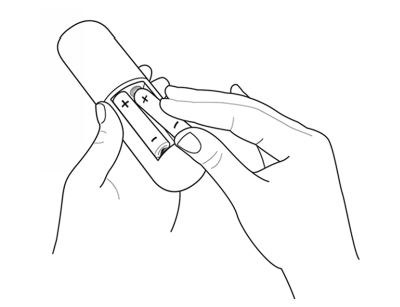
Cautions!
- Batteries should not be exposed to excessive heat, such as sunshine, heat registers, or fire.
- Battery chemicals can cause a rash. If the batteries leak, clean the battery compartment with a cloth. If chemicals touch your skin, wash immediately.
- Make sure that batteries are disposed of correctly. Do not burn or incinerate.
Notes:
- Do not mix batteries of different types.
- Do not mix old and new batteries.
- Remove batteries when the charge is depleted.
- If the remote control is not going to be used for an extended period of time, remove the batteries.
Aiming the remote control
- Point the remote control towards the remote sensor on the front of your TV.
Setting up your TV
When you turn on your TV for the first time, Guided Setup starts. During Guided Setup:
- Your TV automatically detects your wireless network, so have your network name and password handy and follow the easy on-screen instructions.
- You’ll be prompted to create your Roku account online at https://my.roku.com/link. Your TV generates a unique code that links your TV to your new account.
Note: Roku accounts are free, and while a valid credit card number is not required, providing your card information makes renting and purchasing entertainment a breeze. - Once connected to your account, your TV automatically updates with the latest software, and you can start streaming immediately.
Note: If you aren’t ready to connect your TV to a wireless network, you can still use it as a regular TV.
Maintaining
- Do not use your TV in areas that are too hot or too cold, because the cabinet may warp or the screen may malfunction. Your TV works best in temperatures that are comfortable to you.
- Storage temperatures are 5° to 113°F (-15° to 45°C).
- Working temperatures are 41° to 95°F (5° to 35°C).
- Do not place your TV in direct sunlight or near a heat source.
Cleaning your TV cabinet
Clean the cabinet with a soft, lint-free cloth. If the cabinet is especially dirty, moisten a soft, lint-free cloth in a weak detergent solution, squeeze the excess moisture from the cloth, then wipe the cabinet with the cloth. Use a clean cloth to dry the cabinet.
Cleaning your TV screen
Clean the screen with a soft, lint-free cloth.
Troubleshooting
FAQ
For the latest answers to Frequently Asked Questions, visit the Common Questions section at https://www.sharptvusa.com/support and the Support section of the Roku website (https://support.roku.com/index).
Video and audio
| SYMPTOM | POSSIBLE CAUSE | TRY THIS... |
| Picture does not fill the screen or there are black bars around the picture | The picture size may need to be adjusted |
|
| I don’t see a picture when I select an input | TV is not on |
|
| Cables are not connected correctly |
| |
| Picture settings may be incorrect |
| |
| Incorrect input may be selected |
| |
| Input source not detected |
| |
| TV input may be bad |
| |
| TV channel does not appear | Broadcast TV may be experiencing problems or may not be set up |
|
| Dark, poor, or no picture (screen is lit), but sound is good | Broadcast TV may be experiencing problems or may not be set up |
|
| Cables may not be connected correctly |
| |
| Picture settings may be incorrect |
| |
| No color, dark picture, or color is not correct | Picture settings may be incorrect |
|
| Broadcast TV may be experiencing problems |
| |
| Cables are not connected correctly |
| |
| Only snow (noise) appears on the screen | Broadcast TV may be experiencing problems or may not be set up |
|
| Cables may not be connected correctly |
| |
| Picture quality is good on some channels and poor on others. Sound is good | Broadcast signal may be weak |
|
| Dotted lines or stripes appear on the screen | Cables may not be connected correctly |
|
| Broadcast signal may be weak |
| |
| Double images | Broadcast signal may be weak |
|
| The picture has a few bright or dark spots | This is normal in LED TVs |
|
| Good picture, but no sound | Volume is down or muted |
|
| Headphones may be connected |
| |
| TV speakers may be turned off |
| |
| You may need to change the audio mode |
| |
| Home theater system, sound bar, or external speaker system may not be turned on or may not be set up correctly |
| |
| Bad content, no audio |
| |
| Cables may not be connected correctly |
| |
| Poor picture | Light in the viewing area may be interfering |
|
| A connected camera or camcorder may be interfering |
| |
| Audio noise | Other devices may be interfering |
|
| After images appear |
|
Remote control
| SYMPTOM | POSSIBLE CAUSE | TRY THIS... |
| My TV doesn’t turn on using the remote control | No power to TV |
|
| Line-of-sight obstructed |
| |
| Remote not responding |
| |
| TV frozen |
| |
| Trouble programming your existing universal remote control | Remote control may not be programmed correctly |
|
| Batteries may be dead |
|
General
| SYMPTOM | POSSIBLE CAUSE | TRY THIS... |
| No power | Power cord may not be connected correctly |
|
| Other devices may be interfering |
| |
| My TV tuner does not pick up as many over-the-air channels as it should | Antenna may not be placed optimally |
|
| Broadcast TV may not be set up |
| |
| One or more channels do not display | Channels may be blocked or hidden |
|
| The wrong input may be selected |
| |
| You may need to use the remote control that came with the cable or satellite box |
| |
| I lost my parental control PIN | Need PIN recovery |
|
| Some settings cannot be accessed | Not all settings are available for all devices or inputs |
|
| TV cabinet creaks | This is normal |
|
| Control buttons do not work | TV may be frozen |
|
| TV keeps turning off | Sleep timer may be turned on |
|
| Some features are not available | The wrong TV mode may be selected |
|
Roku
| SYMPTOM | POSSIBLE CAUSE | TRY THIS... |
| How can I find out more about using my TV? |
| |
| I can’t turn my TV on with the Roku mobile app | Your TV is “asleep” |
|
| I can’t find my TV with the Roku mobile app | TV and mobile app not on same wireless network |
|
| TV not powered or working normally |
|
Network
| SYMPTOM | POSSIBLE CAUSE | TRY THIS... |
| I cannot connect to the internet | Network connection may not be set up |
|
| Network name or password may have changed |
| |
| Streaming keeps pausing to load more data | Wireless LAN not optimized |
|
| Insufficient broadband speed |
|
CEC-compatible devices
| SYMPTOM | POSSIBLE CAUSE | TRY THIS... |
| My TV is not displaying the video from the connected CEC device | Cables may not be connected correctly |
|
| Picture settings may be incorrect |
| |
| The selected input may be incorrect |
| |
| Connected device may not be a CEC device |
| |
| CEC control may not be set up correctly |
| |
| My TV is not playing the audio from the connected CEC device. | Cables may not be connected correctly |
|
| Volume may be too low or muted |
| |
| TV speakers may be turned off |
| |
| Connected device may not be a CEC device |
| |
| CEC control may not be set up correctly |
| |
| Connected audio device may not be set up correctly |
| |
| My TV’s remote control does not control the device | Connected device may not be turned on |
|
| Line-of-sight obstructed |
| |
| Connected device may not support some or all CEC features |
| |
| CEC control may not be set up correctly |
| |
| The device does not show up in the CEC device list | Connected device may not be a CEC device |
|
| Cables may not be connected correctly |
| |
| CEC control may not be set up correctly |
| |
| My device does not turn off when I turn off my TV | Connected device may not be a CEC device |
|
| Connected device may not support some or all CEC features |
| |
| CEC control may not be set up correctly |
| |
| My TV does not turn on when I turn on my device | Connected device may not be a CEC device |
|
| Connected device may not support some or all CEC features |
| |
| CEC control may not be set up correctly |
|
See other models: DX-B350P AR-M207 MX-M364N XE-A402 LC-32G4U

